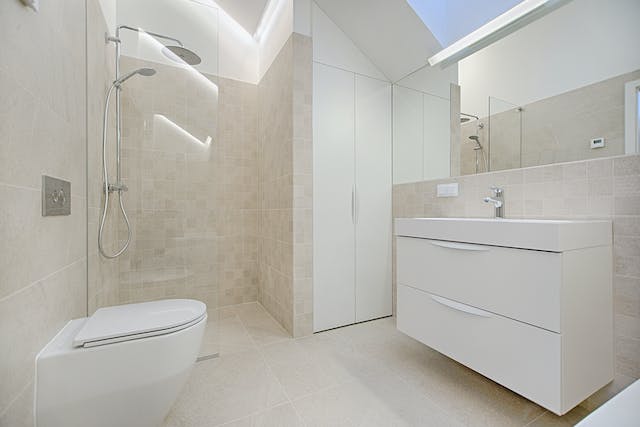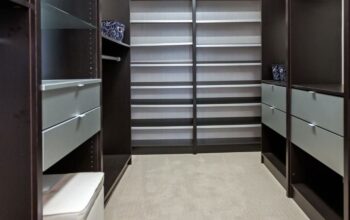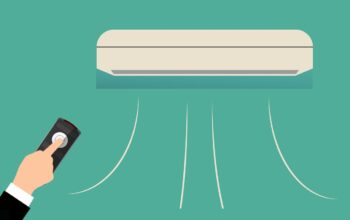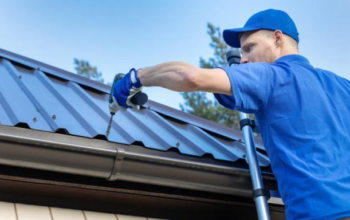Limescale is a hard, off-white, chalky deposit often found in bathrooms, which is caused by the residue of hard water. Hard water is abundant in minerals like calcium and magnesium. When this water evaporates, it leaves behind these minerals that eventually accumulate over time, forming what we know as limescale.
This common issue can lead to dull surfaces and can compromise the efficiency and longevity of bathroom fixtures. Being aware of the causes of limescale is the first step towards prevention and effective cleaning.
If you’re tired of battling limescale in your home, consider investing in water softeners for a long-term solution.
How to identify limescale buildup
Identifying limescale buildup is a relatively straightforward process. It often manifests itself in several common ways.
Stains and discoloration
Limescale often appears as a white or gray residue on the surfaces of sinks, bathtubs, and showerheads. Over time, it can turn a darker color, typically brown or yellow, due to a reaction with soap or shampoo residues.
Rough texture
A tangible sign of limescale is a coarse, gritty texture that you can feel under your fingertips. This texture results from the accumulation of minerals left behind after the water evaporates.
Reduced water flow
If your taps or showerheads are not producing as much water as they used to, or if the water flow is uneven, you may be dealing with a limescale buildup in your pipes or fixtures.
Decreased efficiency of appliances
Appliances that use water, like washing machines or dishwashers, may become less efficient due to limescale. You might notice longer cycle times, decreased pressure, or less effective cleaning.
The impact of limescale on bathroom fixtures
Limescale can severely impact the functionality and aesthetics of bathroom fixtures. The persistent accumulation of this mineral buildup can lead to both superficial and internal damage, turning shiny, smooth surfaces dull and rough, and potentially clogging pipes and fixtures.
For instance, showerheads and taps may start to suffer from reduced water flow, resulting from the blockage created by limescale within the appliance. This not only affects the efficiency of your shower or sink but can also result in increased water usage, leading to higher utility bills.
Even on a cosmetic level, the impact of limescale is significant. It can cause stains and discoloration on your bathroom fixtures that are challenging to remove, tarnishing the overall appearance of your bathroom.
Therefore, it’s crucial to address limescale buildup as part of regular bathroom maintenance to preserve the functionality and aesthetic appeal of your fixtures.
Preventing limescale
Preventing limescale buildup is an integral part of bathroom maintenance. Here are some effective strategies.
1. Regular cleaning
Regularly cleaning your bathroom fixtures with a mildly acidic solution can prevent limescale. Vinegar, for instance, can break down mineral deposits before they harden into limescale.
2. Water softeners
Installing a water softener in your home can prove beneficial. These systems work by replacing calcium and magnesium ions in hard water with sodium ions. This process prevents the formation of limescale, protecting your appliances and fixtures.
3. Monitor appliance performance
Keep a close eye on the performance of your water-using appliances. If you notice decreased efficiency, it might indicate the early stages of limescale buildup. Early detection allows for timely cleaning or repair.
4. Use limescale inhibitors
Limescale inhibitors are substances that, when added to water, prevent the formation of limescale. They can be used in appliances such as washing machines and dishwashers to protect from mineral buildup.
5. Install a scale inhibitor
This device is attached to the incoming main water supply and releases a harmless polyphosphate compound into the water, which stops the buildup of limescale.
Remember, preventive measures may require an initial investment but can save significant time, money, and effort in the long run by extending the lifespan of your bathroom fixtures and appliances.
Related Posts

Loves home. I am here to provide how to make your home a much better place. 🙂 Blogging about HomeDecor, Home Improvements and more.











